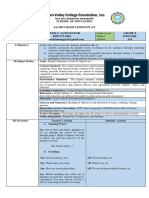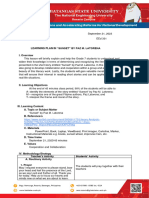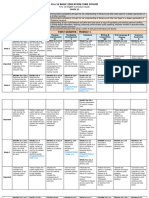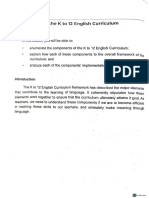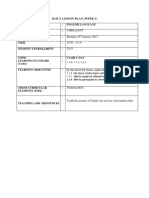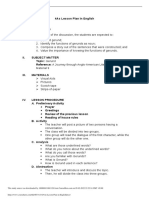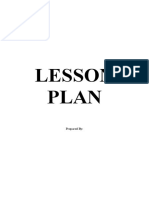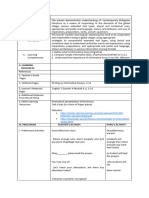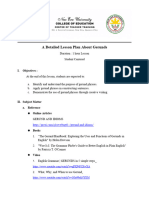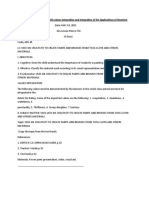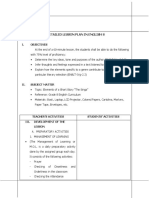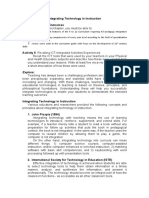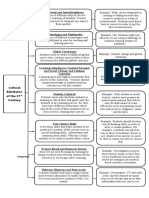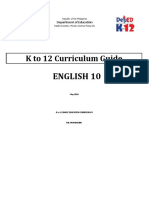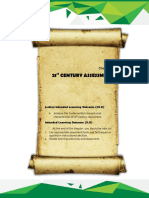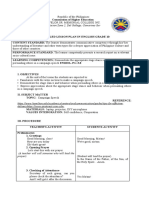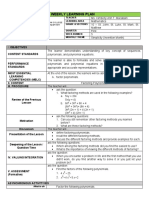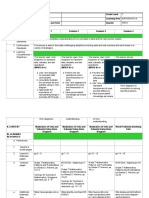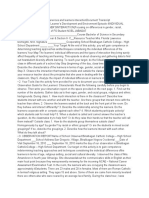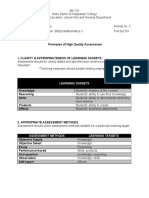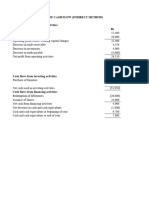SAMPLE LEARNING PLAN
ENGLISH 8, FOURTH GRADING , 12 DAYS
Content Standard
The learner demonstrates an understanding of South and West Asian literature as an expression of
philosophical and religious beliefs, information flow in various text types; reality, fantasy, and opinion in
listening and viewing materials; word decoding strategies; and use of information sources, active/passive
constructions, direct/reported speech, perfect tenses, and logical connectors in journalistic writing.
Performance Standard
The learner transfer learning by composing a variety of journalistic texts, the content of which may be
used in composing and delivering a memorized oral speech featuring the use of properly-acknowledge
information sources, grammatical signals for opinion-making, persuasion, and emphasis, and appropriate
prosodic features, stance, and behavior.
Learning competencies
Use active and passive construction in a journalistic contexts.
Use past and perfect tenses in journalistic writing.
Use direct and reported speech in journalistic writing.
Use appropriate logical connectors for emphasis.
Unit Summary:
In this unit, the students will act like junior reporters as they learn the proper use of logical connectors,
active and passive voices, past and perfect tenses, as well as direct and reported speech in journalistic writing.
The teacher will utilize interactive PowerPoint presentations, sample printed and online articles as well as
related web pages and videos in explaining the grammatical structure and journalistic content of news, opinion,
and feature stories. Based on the discussed concepts, the students will create their own journalistic articles. The
students will then collaborate and make a newspaper spread through MS Publisher. They will be evaluated by
their group members, by other groups and by the teacher. This will be the students’ final output for English in
the 4th quarter. It will be assessed using journalistic standards for content and organization and related grammar
rules. Ultimately, students will appreciate the role of journalism in keeping the society informed and in
forwarding significant changes.
Student Objectives/Learning Outcomes
Week 1
Day 1:
Through an introductory PowerPoint presentations on the concepts of journalism, the students will be
able to:
a. recognize the basic concepts of journalism and news, opinion, and feature writing;
b. describe the personal significance of reading news, opinion, and feature articles to their daily life by
making a creative output (poem, essay, or poster); and
� c. determine through enumeration, the distinct qualities of the given samples of news, opinion, and feature
articles.
Day 2:
By analyzing samples of journalistic articles, the students will be able to:
a. recognize the essential journalistic content and proper grammatical structure of news, opinion, and
feature stories;
b. compare the content and structure of news articles with the two other journalistic texts through a
diagram; and
c. assemble given journalistic content into a properly structured news spread that will serve a model for
their long-term project using MS Publisher.
Day 3:
Through an interactive discussion about the past and the perfect tenses, the students will be able to:
a. identify how to apply past and past perfect tenses in making clear and meaningful sentences;
b. discuss the functions of past and past perfect tenses in writing a journalistic article by a brainstorming
session; and
c. conform to the rules of past and past perfect tenses in rewriting sentences from news, opinion, of feature
articles.
Day 4:
Through an interactive discussion about the active and passive voices, the students will be able to:
a. discern the use of active and passive voices in making clear and meaningful sentences;
b. differentiate the function active and passive voices through a creative dialogue; and
c. revise sentences according to the rules of active and passive voice in journalistic writing.
Day 5:
Through an interactive discussion about direct and reported speech, the students will be able to:
a. determine the proper use of direct and reported speech in writing clear and meaningful sentences;
b. explain the difference between direct and reported speech as used in journalistic articles through a
graded recitation; and
c. convert direct speech into indirect speech and vice versa through a writing activity.
Week 2
Day 6:
Through a PowerPoint presentation on logical connectors, the students will be able to:
a. determine the proper use of digital connectors in writing clear and meaningful paragraphs;
b. explain the different uses of each logical connector as used in journalistic articles through a graded
recitation; and
c. match the clauses with the correct logical connectors through an interactive classroom activity.
�Day 7:
By outlining the basic structure of a news article using a PowerPoint presentation, the students will be
able to:
a. distinguish the steps in writing a primary lead, secondary lead and background in a news article;
b. discuss with others after reviewing online news articles to identify the qualities of a good news lead and
background; and
c. create a news story about a significant current event using a variety of print and non-print resources.
Day 8:
Through watching videos detailing the basics of opinion and feature writing articles, the students will be
able to:
a. identify the essential content and basic structure of opinion and feature articles;
b. illustrate how feature and opinion articles help forward changes in society through a creative output
(poem or comic strip); and
c. review the content and structure of sample opinion and feature articles.
Day 9:
By choosing a video about the pros and cons of an issue posted on a relevant YouTube channel, the
students will be able to:
a. recognize the structure and content of opinion articles;
b. relate the issue tackled in the video to their personal lives through a short essay;
c. compose their own opinion articles by reacting to the video they watched.
Day 10:
By browsing web pages that post “human interest” writing (e.g. Humans of New York), the students will
be able to:
a. point out different angles of human interest that are essential to feature writing;
b. share their favorite anecdotes from the web pages that they browsed and explain why they chose them;
and
c. use a human interest angle to write a feature article about a person inside the classroom that they find
interesting.
Day 11:
By compiling their individual outputs (news, opinion, feature articles), the students will be able to:
a. explain the importance of journalism to keeping citizens informed about the changes happening in
society by making a creative and informative news spread;
b. join others in exploring the effective use of MS Publisher to create news spreads out of their journalistic
works; and
c. construct a news spread that contains the group’s compiled journalistic work using MS Publisher while
following standards of lay-outing, journalistic content and grammar.
�Day 12:
After collaborating with others in creating and showcasing a news spread that contains their new,
opinion, and feature articles, the students will be able to:
a. apply the comments from other groups that are helpful in improving the journalistic content and
grammatical structure of their group’s news spread;
b. share relevant insights with their group members in objectively evaluating the news spread of other
groups; and
c. apply concepts of grammar (direct and indirect speech, logical connectors, past and past perfect tenses,
active and passive voice), journalistic writing, and proper citation of sources in critiquing the news
spreads of other groups.
Daily Procedures
Day 1
1. Start the class with a short prayer.
2. Let students do the “Make What You Know” activity.
3. Start with the introductory lecture on journalism and news, feature, and opinion articles.
a. Ask the students what journalism is.
b. Ask the students, “What is the purpose of journalism?” (List the answers of the students on the
board.)
c. Supplement the students’ answers with this insight:
“The principles and purpose of journalism are defined by something more basic: the function news
plays in the lives of people.” – Bill Kovach and Tom Rosenstiel
d. Let the students write the different types of articles. Ask them to bring out their newspaper.
e. Present the different types of newspaper.
f. Ask the students for insights about why we need to read news.
4. Introduce the activity “There’s a Difference Among the Three.”
a. The students will create a table about the three types of articles.
b. Using the sample articles, the students will enumerate the distinct qualities of the given samples of
news, opinion, and feature articles.
c. The students will list the qualities in the said table.
d. Five minutes before the time, ask the students to pass their paper.
Day 2
1. Start the class with a short prayer.
2. Introduce the game “Put it Back Together.”
� a. Let the students be grouped into seven members each.
b. Give each group one set of articles containing the three types (news, feature opinion). The cutouts of
the given articles must be jumbled but separated according to type.
c. Instruct the class to rearrange the disorganized articles in two minutes.
d. Ask some of the students to read their output in front of the class.
3. Proceed to the basic discussion about the journalistic content of news, opinion, and feature articles.
4. Let students remain in their groups as they explore the functions and features of MS Publisher in relation
to assembling articles.
a. Ask the groups to open their laptops, then click to MS Publisher.
b. Choose a layout of newspaper template. (If the Internet is available, the students are allowed to pick
a template from the web).
c. Ask the students to search for sample articles from the Internet (2 news articles, one opinion article
and one feature article).
d. Instruct the students to paste the content of the given articles in the layout of their newspaper spread
(8.5 inches x 14 inches). This newspaper spread will serve as a model for their long-term project.
e. Five minutes before the time, ask the students to save their output. Instruct them to send their work
in your account in Google docs or Schoology before the class ends. (If the internet is unavailable,
tell the students to send the file before 9pm through e-mail).
Day 3
1. Start the class with a short prayer.
2. Introduce the activity “What’s Wrong with the Sentence?”
a. Prepare the PowerPoint Presentation of the activity.
b. Show the slides.
c. Ask the students to compare the pictures to the sentences by asking “What’s wrong with the
sentences?”
d. Ask the students how they will convert the sentence.
e. Present the answers.
3. Proceed to the discussion about past and past perfect sentences and their importance in journalistic
writing.
a. Ask the class why verb tenses are important in writing sentences and why it is also important in
news writing.
b. Use the handout to review verb tenses.
c. Inform the class that the most common tenses used in news writing are past tense and past perfect
tense. Explain these through the given examples.
d. Through the handout, ask the class to give their own examples.
e. Why are reporters fond of using past tense and past perfect tenses? (Let the students share their
answer in front of the class).
4. Let the students answer an exercise about tenses.
a. Prepare a hard copy of an exercise from www.englisch-hilfen.com.
b. Instruct the students to read the instructions. Remind them to write their names and the date on the
paper.
c. Ask the students to pass their paper a few minutes before the bell rings.
Day 4
1. Start the class with a short prayer.
2. Introduce the students to the activity “The Suspicious Suitcase”.
a. Give the students a handout about passive and active voices.
b. Present the given paragraph.
c. Ask the students to convert the sentences in the paragraph to an active voice. Their answers should
be written in a ½ crosswise piece of paper.
d. Request one of the students to read his/her output in front of the class.
� e. Ask the class what happened to the tone of the story. Did it become more engaging? Interesting?
Why?
3. Let students collaborate in order to create dialogues incorporating the active and the passive voices.
a. The students will group themselves into five groups.
b. Using their handouts, the two students will create a two-person dialogue (for two minutes) using
active and passive voices.
c. They will present their output in front of the class.
4. Present the lesson about the active and passive voices and their relation to journalistic writing.
a. Show the PowerPoint presentation. Give a review on voices.
b. Explain the function of active and passive voices. Give examples.
c. Explain how to apply active and passive voices in writing a news article. Give examples.
d. Explain how to change a sentence from the active voice to the passive voice. Give examples.
e. Let the students explain how active voice gives an interesting news story and how the passive voice
is applied.
5. Let students answer the activity “Modified Active or Passive Voice”.
a. Prepare the following headlines in a Manila paper.
Toronto named ‘most youthful’ city in the world
Two baby baboons on display at Brooklyn zoo
Taylor Swift had just won top prize at American Music Awards
Scottish government revealed their independence plan
World’s first solar power plane takes flight in Hawaii.
Obama was elected president for the second term
Mothers ask nearly 300 questions a day
b. Instruct the students to write the sentences in one whole sheet of paper. Leave three spaces after each
sentence.
c. Explain to the students that one of the headlines presented is in the active voice and some are in the
passive voice. Some of the headlines will stay the same while other headlines will remain the same.
If they will rewrite a sentence, they should write (in one sentence) why they should convert the
headline to active or passive voice.
d. Instruct the students to pass their paper a few minutes before the bell rings.
Day 5
1. Start the class with a short prayer.
2. Introduce the activity “What Did They Just Say?”
a. Show the video clip: Kurbaan – classroom Debate Scene – Vivek Oberoi (2 minutes and 47 seconds
long).
b. Repeat the video. Ask the students to take down the important line on a scrap paper.
c. Instruct the students to rewrite their chosen lines and compile each in a paragraph. Ask them to
present their output in a ½ crosswise piece of paper.
d. Ask the students to pass their papers after 10 minutes.
3. Proceed to the discussion about direct and indirect speech and their relation to journalistic writing.
a. Ask the class why they converted the lines in the video.
b. Start the PowerPoint presentation. Ask what is direct and reported speech. These are the two ways to
report what someone says or think.
c. Give the functions of direct and reported speech. Give examples.
d. Explain how to apply direct and reported speech in writing a news article. Ask the student to convert
the given examples.
e. Do you think knowing direct and reported speech will help you in news writing? How?
4. Introduce the activity “Tell Me About Yourself”.
a. The class will group themselves in pairs.
� b. One interviews the other. The content of their interview should focus on one trait about the person.
(Crushes, Hobbies, Talents, Family). The interview consists of only five questions. They will write
their answers on the upper half of the one whole sheet of paper.
c. After five minutes, the two students will exchange places. The first person who was interviewed will
now interview his/her partner.
d. After five minutes, the two students will now paraphrase the answers into a sentence; thus,
converting direct speech to indirect speech (or vice versa) whenever necessary. The students will
compile it into a paragraph.
e. Ask the students to pass their paper a minute before the bell rings.
Day 6
1. Start the class with a short prayer.
2. Let students engage in the activity “Add What is Missing”.
a. Present copies of the article.
b. Instruct the class to fill in the blanks to complete the article.
c. After 10 minutes, ask the class to paste their papers. Ask what words are missing in the article. Let
them discuss.
3. Use an interactive PowerPoint presentation called “The Missing Link”.
a. Explain that a particular journalist needs their help to finish his news article. Introduce the character
of the PowerPoint presentation. Then give the definition of the lesson.
b. As you fill in the blanks in the article, give the different types of logical connectors. Show examples.
c. After the class has helped the character finish the article, ask them the importance of logical
connectors.
4. Introduce the activity “Can You Help His Friends?”
a. The PowerPoint presentation will provide an exercise for the students to apply logical connectors in
opinion and feature articles.
b. The students will fill in the blanks with the appropriate logical connector.
c. The students will then use their answers to rewrite the given article in an intermediate paper.
d. Ask the students to pass their paper a few minutes before the bell rings.
5. Introduce to the class their assignment. Instruct them to gather information about a newsworthy recent
event in their school. For example, a student who won an award in an inter-school competition or a
program in school that will be held next week. The information can be gathered by interviewing
knowledgeable authorities or consulting other reliable sources (e.g. the school website)
6. Give the instructions for the class’ online quiz.
a. Instruct the students to log in to Edmodo after classes.
b. Ask them to download the file: Logical Connector Quiz. doc.
c. The students will then answer the questions of the given quiz.
d. Instruct the class to submit their outputs to the teacher’s Edmodo account before 9pm on Day 7.
Day 7-8
1. Start with a prayer to be led by one of the students.
2. Use a PowerPoint presentation to discuss the lesson about news writing.
The first slides will flash a few headlines. Ask the students what they know or what they can assume
about these headlines.
a. ‘AlDub’ rice paddy art hopes to attract millennials to farming
b. Duterte ties Poe in latest Pulse Asia poll
c. Talk about the basic structure of a news article. Include samples of newspaper articles from print
publications and online news sites in the presentation. The discussion will take 15 minutes.
d. At the end of the lecture presentation, instruct the students to make personalized diagrams that
outline the basic structure of a news articles in their notebooks.
e. After five minutes, flash samples of diagrams that describe the structure of news articles for students
to compare and refine their outputs, if needed.
� f. Ask the students what kind of news lead makes them want to read the entire article and what they
think are the qualities of a good news article background. Allow students to discuss their answers
with their seatmates. After a few minutes, ask some of them to share their responses briefly.
g. Using their homework from Day 6, instruct the students to work individually on a news article about
a significant issue within their school through Microsoft Word.
h. Tell the students to properly cite their sources in the news article (e.g. printed materials or
knowledgeable authorities).
i. Remind the students of their final project, a newspaper spread comprised of four pages. Inform the
students of their groups, composed of five members each. All writing outputs will be uploaded to
Google Drive through a folder that will be accessed by the teacher and the groups.
j. Distribute the rubrics for the newspaper spread for students’ reference in conceptualizing and
designing their newspaper spreads as well as for future evaluation of other groups’ works. Groups
can start compiling their works and designing their newspaper spread starting today.
3. Look for lecture videos on YouTube detailing the basics of opinion and feature articles. Show these
videos to the class. The videos will take about 5 minutes each.
Opinion writing: https://www.youtube.com/watch?v=V8Gu3Md5r-M
Feature writing: https://www.youtube.com/watch?v=Ec0IsuIAcXw
4. Give a skeletal structure of an outline for the two videos in which the basic content and structure of
opinion and feature articles are identified.
a. Type of Article
b. Essential Content of the Article
c. Parts of the Article and Description
d. Additional Tips
e. Tell the students to fill in the outlines on their notebooks.
f. Distribute samples of opinion and feature articles. Each student will have one sample of each.
g. From these articles and the videos they previously watched, ask students to review the content and
structure of opinion and feature articles by creating mnemonic devices.
h. According to their individual preferences, the students can make a short poem or comic strip that
illustrates how feature and opinion articles help forward changes in society. They will be given the
rest of the hour to complete this on a short coupon bond.
Day 9
1. Start with a prayer to be led by one of the students.
2. Ask students if they are on social media and ask which sites they frequently used.
3. Pose the question, “Do you think social media is good or bad for you as an adolescent?” Ask students to
raise their hands to present their opinion. Count votes for Good and Bad.
4. Let students watch a video about the Pros and Cons of social media. The Pros and the Cons of Social
Networking and Adolescents: https://www.youtube.com/watch?v=SAYwQM7OaA
5. Once again, ask the questions, “Do you think social media is good or bad for you as an adolescent?” Ask
the students to raise their hands to present their opinion. Note the difference in the number of students
who voted for Good and for Bad before and after watching the video. Ask them how watching the video
affected their opinions.
6. Ask the students to work by pairs and briefly answer the following questions on an intermediate pad:
a. What was the video about? Answer in 1-2 sentences.
b. How was the video structured in terms of:
the introduction?
presenting the Pros?
presenting the Cons?
conclusion?
c. How does the structure of the video compare with the structure of an opinion article, as discussed
previously?
� d. How is the topic of the video related to your personal life and experiences? Answer in 4-6 sentences.
7. Let students explore YouTube for videos that talk about the pros and the cons of one of the following
topics:
a. Technology in the classroom
b. School Uniforms
c. K to 12 Curriculum in the Philippines
8. Tell students to write an opinion article reacting to the video they watched. Through the article, they will
make a stand on the issue they chose and justify it by logical analysis and citing reliable sources. Allow
them to use the internet to search for credible sources. They will be given the rest of the hour to
complete this on Microsoft Word.
9. For their assignment, ask students to conduct a short interview with a person in the classroom they find
interesting. Encourage them to choose someone they are not really close to but would like to know
better. The interview will be used to make a basic personality sketch (e.g. personal detail such as the
interviewee’s birthdate, educational background, information about parents and siblings).
Day 10
1. Start with a prayer to be led by one of the students.
2. Compile and flash literary pieces from the website www.artparasites.com
In a PowerPoint presentation. Ask students how they felt after reading the passages.
3. Ask the students, “How were those passages able to appeal to you?”
4. Recommend some websites and pages that post “human interest writing” (e.g. Humans of New York)
and let students explore the internet for 10 minutes to read through more samples.
5. Ask the students which anecdotes they liked the most. Let them explain why they chose them as their
favorite.
6. Present a blank sample of a word web about the different human interest angles in feature writing.
7. Let students complete their own word web on Microsoft Word. Afterwards, tell them to briefly answer
the question, “Why are human interest angles important in feature writing?”
8. Tell students to bring out their homework (basic personality sketch). They will use an appropriate
human interest angle to write a feature article about the person they interviewed.
9. Allow students to approach the person they chose as subject in order to ask follow-up questions for their
article.
10. After completing the necessary information, the students will be tasked to finish their feature articles on
Microsoft Word.
11. Assign the completion and the revision of all the students’ journalistic articles as their homework.
Another assignment is to bring soft copies of all the articles (news, opinion, and feature) that they make.
Day 11
1. Start with a prayer to be led by one of the students.
2. Instruct students to imagine a world where there are no journalists and media (radio, TV, etc.).
3. Using colored chalk, the students will write their ideas (words or phrases) on the blackboard in the form
of graffiti.
4. Present a short lecture about news spreads as a form of journalistic publication including a sample layout
of a news spread. This lesson serves as a refresher of what was learned from the previous week (Day 2).
5. Instruct students to sit with their group members as they finish compiling the soft copies of their articles.
Remind them to participate actively because they will be evaluated by their peers using the given
rubrics.
6. Allow groups to explore the effective use of Microsoft Publisher in making a newspaper spread.
Students will submit their final output via Google Drive before 12 midnight of that day.
7. Before leaving the room, tell students to submit their peer evaluation by group.
Day 12
1. Start with a prayer to be led by one of the students.
�2. Make a slideshow preview of all the outputs submitted yesterday.
3. Review the rubrics given for evaluating newspaper spreads. Assign groups to exchange their newspaper
spreads for checking (e.g. Group 1 and Group 2, 3 and 4, and so on).
4. Let students within each group sit together as they rate the newspaper spreads of the group assigned to
them. They must write comments when they rate the outputs of the other group. They will do this for 30
minutes.
5. Groups will exchange their written comments with each other. Each group will decide which comments
to accept in order to improve their output.
6. Instruct students to make final revisions of their output using MS Publisher.
7. At the end of the period, ask students to upload their finalized output using the appropriate folder in
Google Drive. These will be rated by the teacher. The final project will be worth 100 points, 50 points
from the Peer Evaluation, and 50 points from the teacher (using the same rubric).


